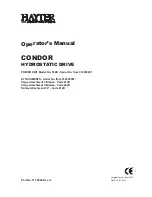
5
English |
Original instructions
ELECTRICAL
GENERATOR CAPACITY
Make sure the generator can supply enough continuous
(running) and surge (starting) watts for the items you will
power at the same time. Follow these simple steps.
1. Select the items you will power at the same time.
2. Total the continuous (running) watts of these items. This
is the amount of power the generator must produce to
keep the items running. See the wattage reference
chart at right.
3. Estimate how many surge (starting) watts you will need.
Surge wattage is the short burst of power needed to
start electric motor-driven tools or appliances such as a
circular saw or refrigerator. Because not all motors start
at the same time, total surge watts can be estimated by
adding only the item(s) with the highest additional surge
watts to the total rated watts from step 2.
NOTE:
The total generator output required, which is the
sum of the continuous (running) and the surge (starting)
watts, are based on the standard environment ambient
air temperature (25 °C/298 K), ambient air pressure
(100 kPa), and relative humidity (30%). The continuous
(running) and surge (starting) watts will be different when
the environmental conditions change.
Example:
Tool or
Appliance
Running Watts*
Additional Starting
Watts*
Refrigerator
700
1350
Portable fan
40
120
Laptop
250
250
46" flat panel
television
190
190
Light (75 Watts)
75
75
1255 total
Running watts
1350 highest
starting watts
Total Continuous (Running) Watts
1255
Plus Highest Additional Surge Watts
+1350
Equals Total Generator Output Required
2605
POWER MANAGEMENT
To prolong the life of the generator and attached devices,
it is important to take care when adding electrical loads to
the generator. There should be nothing connected to the
generator outlets before starting its engine. The correct and
safe way to manage generator power is to sequentially add
loads as follows:
1. With nothing connected to the generator, start the
engine as described later in this manual.
2. Plug in and turn on the first load, preferably the largest
load (highest wattage) you have.
3. Permit the generator output to stabilise (engine runs
smoothly and attached device operates properly).
4. Plug in and turn on the next load.
5. Again, permit the generator to stabilise.
6. Repeat steps 4 and 5 for each additional load.
7. Never add more loads than the generator capacity.
Take special care to consider surge loads in generator
capacity as previously described.
CAUTION
Do not overload the generator’s capacity. Exceeding the
generator’s wattage/amperage capacity can damage the
generator and/or electrical devices connected to it.
Application/Equipment
Estimated
Starting
Watts*
Estimated*
Additional
Starting
Watts
Emergency / Home Standby
Lights (qty. 4 x 75 W)
300
300
Refrigerator
700
1350
46" flat panel television
190
190
Satellite receiver
250
250
Portable fan
40
120
Heater
1300
1300
Laptop
250
250
Slow cooker
270
270
Radio
50
50
DIY/Job Site
Electric drill − 10 mm (3/8")
600
1000
Quartz halogen work light
1000
1000
Reciprocating saw
960
1920
Circular saw − 184 mm (7-1/4")
1400
2300
Mitre saw − 254 mm (10")
1800
1800
Air compressor − 1/4 HP
970
1600
Airless sprayer − 1/3 HP
600
1200
*Wattages listed are approximate. Check tool or appliance for actual wattage.
FEATURES
KNOW YOUR GENERATOR
See Figure 1.
The safe use of this product requires an understanding of
the information on the product and in this operator’s manual
as well as a knowledge of the project you are attempting.
Before use of this product, familiarise yourself with all
operating features and safety rules.
240 V AC OUTLETS
Your generator has two single phase, 50 Hz outlets that
are 240 V AC outlets. These can be used for operating
appropriate appliances, electrical lighting, tools, and motor
loads.
AIR FILTERS
The air filters help to limit the amount of dirt and dust drawn
into the engine during operation.
AUTO IDLE BUTTON
The auto idle button is used to control the speed of the
engine and conserve fuel. When Auto Idle is on and no
Summary of Contents for RIG2000PCB
Page 1: ...RIG2000PCB ORIGINAL INSTRUCTIONS Digital Inverter Generator...
Page 4: ...Fig 7 Fig 3 Fig 4 Fig 5 Fig 6 Fig 2 19 11 10 9 20 19 16 18 28 29...
Page 5: ...Fig 9 Fig 9 Fig 8 Fig 10 Fig 11 Fig 12 Fig 13 4 23 22 21 20 24 25 26 18 24...
Page 6: ...Fig 14 Fig 15 27 5 21 21 21 21...
Page 7: ......
Page 21: ...WIRING DIAGRAM...
Page 22: ......
Page 23: ......










































